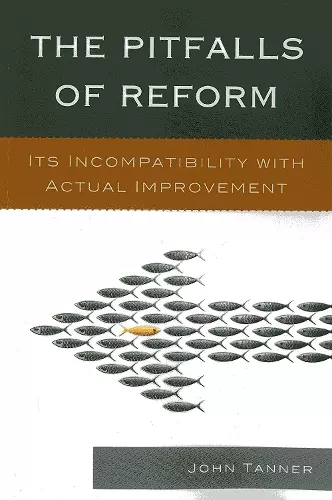The Pitfalls of Reform
Its Incompatibility with Actual Improvement
Format:Paperback
Publisher:Rowman & Littlefield
Published:16th Dec '13
Currently unavailable, and unfortunately no date known when it will be back

The systems that make up the accountability package in education: standards, assessments, and the quality determination for a school, have each entered the educational field under the explicit assumption by their creators that they would drive educator behavior in a positive way. But what if that isn’t actually the case? What if each of the components was actually designed for another purpose entirely and now is tasked with a role that was never considered in its design? If that is the case those who put the systems in place risk expecting a result that the system was never designed to produce. That is exactly where we find ourselves today. In education the misalignment between what the systems were designed to do and the intent of those who selected them is masked in the sheer complexity of the educational exercise. What this book does so marvelously is unravel that complexity and present the contradictions in a clear, coherent manner. Understanding these contradictions is the first step towards actual improvement.
This is a book that offers a new theory regarding educational accountability. As a theory, these ideas are not the final word on these topics, and John says as much in the process of sharing his ideas. But these ideas provide strong explanations for the current situation we face in education and provide a pathway for potential solutions. It is a book well worth the time spent to read and one that can fundamentally reshape our thinking about to improve learning for students across the country. -- David J. Ruff, executive director, Great Schools Partnership
Tanner gets it. If we want to change and improve our schools, we need to discard the mental models and practices that either freezes most of what we do now in place or tries to force us to work harder at what we already do that already does not work. If we want to change the work we do and change the results we get, we need to change the system. Changing our current system requires we find a new box to think inside of. John Tanner has created a compelling design for a new box. -- Doug Christensen, Nebraska Commissioner of Education, emeritus commissioner of education (Nebraska), professor of leadership in education, graduate division, Doane College
John Tanner's shows us just how test scores can be used to improve our schools or to hurt them. This book will be helpful to anyone who wants to become more sophisticated about school accountability and figure out how best to improve educational outcomes for all our children. -- Peg Tyre, author of “The Good School” and “The Trouble With Boys”
In true Tanner fashion, there is no holding back. He takes on current school improvement efforts and all the glory that goes with them and reminds the reader that common sense for school reform is being trumped by common practice! It was like reading a novel that I was in. If we all learn something from what is written in this book, schools and our students will have a fighting chance for success. -- Russell J. Quaglia, Author of School Voice: The Instrument of Change; Principal Voice: Listen, Learn, Lead; and, Aspire High: Imagining Tomorrow’s School Today, Executive Director, Quaglia Institute for Student Aspirations
Tanner takes on education reformers in this excellent treatise about why K-12 reform mostly fails and what to do about it. Tanner skewers most of what passes for reform, including the establishment of rigid standards in core subjects followed by teaching focused on test content followed by, ideally, improved test scores. The author turns to a discussion of the major constraints impeding meaningful reform in schools. Those constraints include issue of time, school readiness, attitudes toward teachers, and others. Tanner employs an approach popularized by the business writer Eliyahu Goldratt to organize schools around the constraints. For example, time is universally considered to be a major problem in schools due to the fact that the time devoted to learning is essentially the same from school to school and student to student. To organize schools around this constraint might mean permitting schools to add time for learning in innovative ways. This may take the form of extending calendars, rejecting the notion that most students graduate in 12 years, etc. The author's use of the Goldratt strategy provides interesting paths to improve schools. Summing Up: Highly recommended. All readership levels. * CHOICE *
ISBN: 9781610489232
Dimensions: 232mm x 150mm x 12mm
Weight: 268g
192 pages